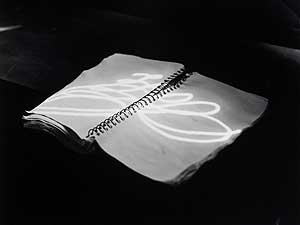|
Audio
Photos
More from MPR
Resources
Your Voice
|
Light Bound: Photographers Regard the Book
March 31, 2004
 |
| Photographer James Henkel plays with words and light in his photograph "Light Drawing." (Photo by James Henkel) |
Minneapolis, Minn. — It doesn't take much to figure out why curator Christian Peterson organized "Light Bound;" he loves books. But the connection is not just personal. Books and photographs have a long shared history, ever since photographs made the transition off metal plate daguerrotypes and onto paper.
 | |||
"Most original photographs were distributed in book form in the 19th century," says Peterson. "Before photos could be reproduced in the 1880's and 1890's, in order to include a photographic image of something in any publication - including newspapers and magazines - actual photographs would be pasted into these publications."
For decades people turned to books to find photographs. Now it seems Peterson has found a way to use photographs to rediscover books. As Associate Curator of Photography, Peterson sees a lot of pictures as they come in and out of his office. Recently he noticed a trend; photographers making images of books. Several were just laying the book open to an interesting two page spread and shooting it, but Peterson says others were far more creative.
"Something as maybe mundane as a book itself, needs to have a photographer do something to it, by choice of book, and then how they've opened it how they've lit it - what they've put in the frame with the book to interact with it. I think in every case here these transform the specific subjects completely," says Peterson.
 | |||
"Light Bound" features the work of seven very different artists. There is collage art, wallpaper made from images of books, and both color and black and white photographs. Artist Alison Rossiter makes photograms of books, much like x-rays, with the spines open and the pages fanned out. Some look like birds taking off in flight, while others resemble a flower or a burst of flames.
"They're so luscious because they're so simple and so strong graphically," says Peterson. "They're just hard to not like."
While Rossiter gives books a sense of life and movement, artist Doug Keyes is more occupied with information contained within. His photographs are the results of long exposures. Keyes opens the camera's shutter, then turns the book's pages several times. The final image appears almost three dimensional, as though the viewer could absorb the entire contents of the book if they stared long and hard enough. Curator Christian Peterson says it reminds you of the way we actually read.
 | |||
"And that is one page at a time - one word, one paragraph, one page at a time. It's a cumulative affect, what gets into our head over a lifetime," says Peterson.
On the opposite side of the room hangs a photograph of a notebook. A beam of light scribbles across the page like a pen. Artist James Henkel says he wanted this image to capture the ephemeral nature of photography while also underscoring the transcendent nature of books.
"What is interesting about them is all the things that we bring to them as individuals," says Henkel, "the ideas that we have about them as a culture, the ideas that we each bring to them through our own experience with books."
Henkel didn't have a great relationship with books to start out. He had a learning disability as a child which made it difficult to read. He says you can see the results in his work.
 | |||
"What interests me is being able to go in and alter the book or alter our perception of what the book might be about. - and in some of these books, or in a lot of them - there's a sense of being able to change it, to make it mine," says Henkel. "No longer is it a struggle but it's something that I've been able to reinvest with my own personality."
Henkel says he was afraid to harm books when he first started working with them. They had a sense of finality and authority that he didn't dare mess with. Everything he did to the book for the photograph could be undone. But over time he changed his mind.
"There are so many books out there," says Henkel. "When I go to Good Will they cost 50 cents and if I don't do something to them they're going to be converted back into paper. So I'm just sort of borrowing them for a little while."
 | |||
Henkel submerged books in water, and dried them out. Their pages warped and curved like layers of rock in a cliff-face. Henkel says that moment was freeing; suddenly anything was possible. He says his work praises not the book itself, but what it can become: a vehicle, a symbol, or a source of inspiration. He says his wife calls his work "imaginative drift."
"I was the student who after you read about two pages you stop and say 'Oh my God! Where was I? What did I just read?' Because imaginatively I've left the book. These are in some ways representations of that idea," says Henkel.
Henkel's latest work involves shredding books with a bandsaw and then reassembling them in new ways. He says he sometimes horrifies his friends who collect books. But his relationship to the literary world has definitely improved over the years. He married a writer and now lives in a house filled with books.
|
News Headlines
|
Related Subjects
|
